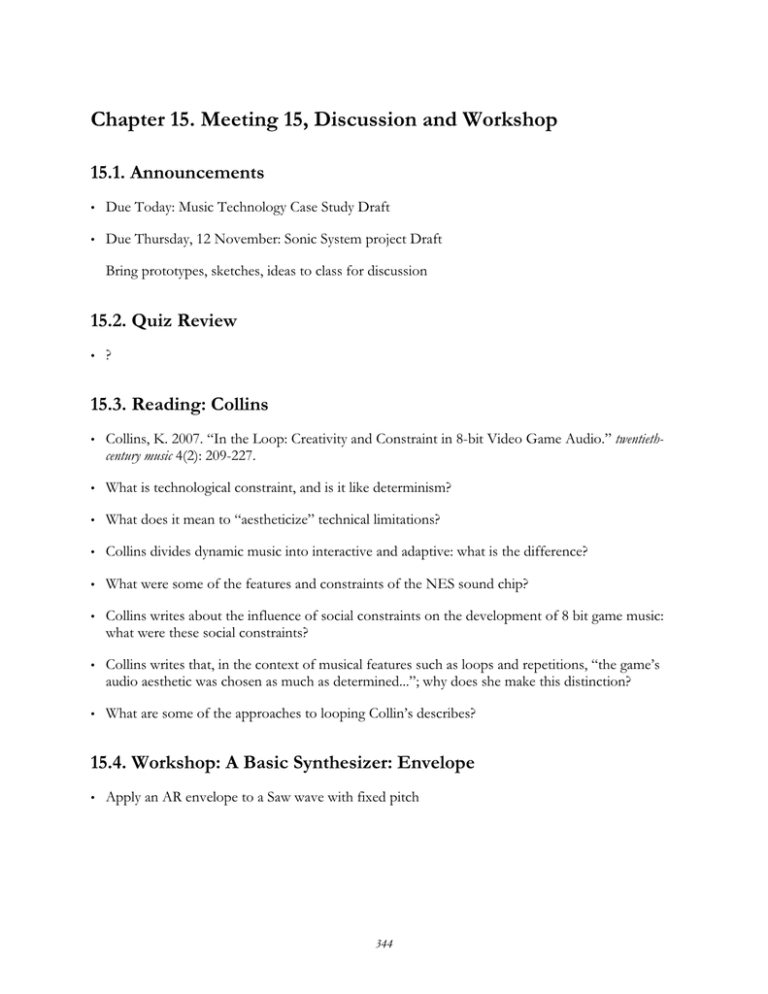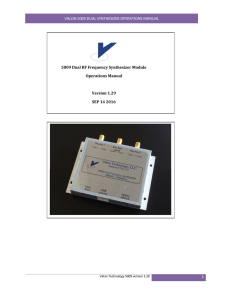
Chapter 15. Meeting 15, Discussion and Workshop
15.1. Announcements
•
Due Today: Music Technology Case Study Draft
•
Due Thursday, 12 November: Sonic System project Draft
Bring prototypes, sketches, ideas to class for discussion
15.2. Quiz Review
•
?
15.3. Reading: Collins
•
Collins, K. 2007. “In the Loop: Creativity and Constraint in 8-bit Video Game Audio.” twentiethcentury music 4(2): 209-227.
•
What is technological constraint, and is it like determinism?
•
What does it mean to “aestheticize” technical limitations?
•
Collins divides dynamic music into interactive and adaptive: what is the difference?
•
What were some of the features and constraints of the NES sound chip?
•
Collins writes about the influence of social constraints on the development of 8 bit game music:
what were these social constraints?
•
Collins writes that, in the context of musical features such as loops and repetitions, “the game’s
audio aesthetic was chosen as much as determined...”; why does she make this distinction?
•
What are some of the approaches to looping Collin’s describes?
15.4. Workshop: A Basic Synthesizer: Envelope
•
Apply an AR envelope to a Saw wave with fixed pitch
344
15.5. Workshop: A Basic Synthesizer: Looping Pitches
•
Loop through a list of MIDI pitches with [mgListLoop]
345
15.6. Workshop: A Basic Synthesizer: Mixing Oscillators
•
Combine oscillators with different waveshapes in different octaves and tunings
346
15.7. Workshop: A Basic Synthesizer: Signal Pitch Control
•
Convert the MIDI pitch value to a signal and low-pass filter [lop~ 20] to smooth transitions
347
15.8. Workshop: A Basic Synthesizer: LPF Envelope Modulation
•
Modulate the cutoff frequency of the low pass filter [moog] with an AR envelope
348
15.9. Workshop: A Basic Synthesizer: LPF Modulation with LFO
•
Modulate the cutoff frequency of the low pass filter with a sine wave [osc~ 0.15]
349
15.10. Workshop: A Basic Synthesizer: AM Tremolo
•
Modulate the amplitude between 0 and 1 below the audio rate
350
15.11. Workshop: A Basic Synthesizer: Ring Modulation
•
Modulate the amplitude between -1 and 1 above the audio rate
351
15.12. Workshop: A Basic Synthesizer: Vibrato
•
Modulate the oscillator frequency between -0.1 and 0.1 MIDI steps at a slow rate (6 Hz)
352
15.13. Workshop: A Basic Synthesizer: Frequency Modulation
•
Modulate the oscillator frequency between -4 and 4 MIDI steps at a fast rate (40 Hz)
353
15.14. Workshop: A Basic Synthesizer: Filtered Noise
•
Use a low-pass filtered noise for a percussion sound
354
15.15. Hardware Hacking: Oscillator Clock Controlled Sequencer
•
74C14 Oscillator (Collins 2009, p. 135)
355
© Routledge. All rights reserved.
This content is excluded from our Creative Commons license.
For more information, see http://ocw.mit.edu/fairuse.
•
CD4017: decade counter, providing 10 output voltages at rate determined by a clock (Collins
2009, p. 208)
Cycle lengths can be altered by connecting an output to the reset input
356
© Routledge. All rights reserved.
This content is excluded from our Creative Commons license.
For more information, see http://ocw.mit.edu/fairuse.
357
•
CD4046: Voltage controlled oscillator (capable of pitch tracking) (Collins 2009, p. 204)
© Routledge. All rights reserved.
This content is excluded from our Creative Commons license.
For more information, see http://ocw.mit.edu/fairuse.
358
•
VCO driven by voltages of the CD4017 (Collins 2009, p. 209)
© Routledge. All rights reserved.
This content is excluded from our Creative Commons license.
For more information, see http://ocw.mit.edu/fairuse.
359
•
Alternative examples
YouTube (http://www.youtube.com/watch?v=FqWzJt3Nm-U)
360
15.16. Workshop: A Basic Synthesizer: Sequencer Pitch Control
•
Counter controlled selection between 8 different MIDI pitch values
15.17. Workshop: A Basic Synthesizer: Sequencer Pitch and Rhythm
Control
•
Apply event triggers to pitched sequencer value selection and rhythm amplitude list loop
Selecting triggers from a counter provides rhythmic subdivisions
361
15.18. Workshop: A Basic Synthesizer: Sequencer Control with SAH
Random LPF Modulation
•
Use noise through a SAH to produce random LPF cutoff frequencies applied ot noise
362
15.19. Listening: Vaggione
•
•
Audio: Horacio Vaggione, "24 Variations," 2002
Contemporary electro-acoustic music employing approaches to sample layering, transformation,
and micro-organization (micromontage and granular synthesis)
363
MIT OpenCourseWare
http://ocw.mit.edu
21M.380 Music and Technology (Contemporary History and Aesthetics)
Fall 2009
For information about citing these materials or our Terms of Use, visit: http://ocw.mit.edu/terms.








